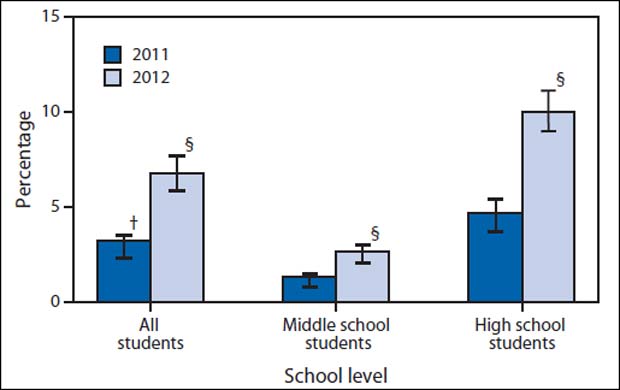E-Cigarette Use Among Middle and High School Students Has Doubled
WASHINGTON, D.C. — New data released today by the Centers for Disease Control and Prevention (CDC) show an alarming increase in e-cigarette use among middle school and high school students in the U.S. From 2011-2012, the number of students in grades 6-12 reporting having ever used an e-cigarette doubled from 3.3 percent to 6.8 percent. Recent use of e-cigarettes among 6-12 year olds increased from 1.1 percent to 2.1 percent.
These troubling numbers highlight the urgent need for the Obama Administration to move forward with regulating e-cigarettes, cigars and other tobacco products. None of these products are currently under the authority of the Food and Drug Administration (FDA). E-cigarettes are sold in dozens of flavors that appeal to kids, including cotton candy, bubble gum, Atomic Fireball, and orange cream soda. Because e-cigarettes are a relatively new tobacco product, most states do not have laws prohibiting the sale of e-cigarettes to kids. One recent study estimated that there are over 250 different e-cigarette brands for sale today, over half of which offered fruit and candy flavors. The three major cigarette companies now also sell e-cigarette products.
“Using an e-cigarette can begin kids on a lifelong addiction to nicotine and tobacco products,” said Paul G. Billings, Senior Vice President for Advocacy and Education. “These data show the urgent need for oversight of these products. The Obama Administration must halt its delay and the FDA must propose meaningful regulation of these product to protect to the public health.”
The Family Smoking Prevention and Tobacco Control Act (Tobacco Control Act), which became law in 2009, gave FDA immediate authority over cigarettes and smokeless tobacco products. The Tobacco Control Act also gave FDA the ability to then assert authority or “deem” jurisdiction over all other tobacco products, including cigars, e-cigarettes, hookah and pipe tobacco – the next generation of tobacco products that are being used to target kids. So far, the Obama Administration and FDA have failed to move forward with asserting that authority.
The CDC study also shows that while e-cigarette use is most common among youth who use traditional cigarettes, a significant percent of youth are only using e-cigarettes, especially among younger age groups. Among middle school students who have ever used an e-cigarette, 20.3 percent said they never smoked a traditional cigarette, compared to 7.2 percent among high school students.
“With flavors like bubble gum and cotton candy, e-cigarettes are very clearly being made and marketed in ways that appeal to children,” said Billings.
According to an initial study conducted by the FDA in 2009, toxic chemicals and carcinogens were found. Two other initial studies have found formaldehyde, benzene and tobacco-specific nitrosamines (a carcinogen) coming from the secondhand smoke emissions from e-cigarettes.
# # #
About the American Lung Association
Now in its second century, the American Lung Association is the leading organization working to save lives by improving lung health and preventing lung disease. With your generous support, the American Lung Association is “Fighting for Air” through research, education and advocacy. For more information about the American Lung Association, a holder of the Better Business Bureau Wise Giving Guide Seal, or to support the work it does, call 1 800 LUNG USA (1 800 586 4872) or visit www.lung.org.
American Lung Association • 1301 Pennsylvania Ave., NW • Washington, DC 20004-1725
1-800-LUNG-USA (1-800-586-4872) • www.Lung.org



